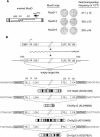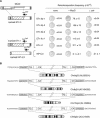An active murine transposon family pair: retrotransposition of "master" MusD copies and ETn trans-mobilization
- PMID: 15479948
- PMCID: PMC525684
- DOI: 10.1101/gr.2924904
An active murine transposon family pair: retrotransposition of "master" MusD copies and ETn trans-mobilization
Abstract
The ETn (Early Transposon) elements are among the most active murine mobile sequences, being responsible for a series of mutations by insertion in vivo. Yet they are noncoding, and it had long been suspected that ETn are mobilized in trans by coding-competent elements, most probably from the closely related MusD family of LTR-retrotransposons. A genome-wide in silico search for coding-competent MusD elements identified a total of nine such copies, which we cloned and marked to test their transpositional activity, using an ex vivo assay in heterologous cells. Three copies were found to be autonomous for transposition, with each gag, pro, and pol MusD gene absolutely required for mobility. These active MusD copies specifically trigger retrotransposition of marked ETn elements with high efficiency, by complementation in trans. Characterization of the structures of de novo transposed MusD and ETn marked elements, as well as of their integration sites, disclosed canonical retroviral-like retrotransposition, with 6-bp target site duplications common to both elements. These results highlight the parasitic molecular strategies that are used by the ETn elements for their mobility, and unambiguously identify their "master genes."
Figures





References
-
- Baust, C., Baillie, G.J., and Mager, D.L. 2002. Insertional polymorphisms of ETn retrotransposons include a disruption of the wiz gene in C57BL/6 mice. Mamm. Genome 13: 423-428. - PubMed
-
- Boeke, J.D. and Stoye, J.P. 1997. Retrotransposons, endogenous retroviruses, and the evolution of retroelements. In Retroviruses (eds. J.M. Coffin et al.), pp. 343-435. Cold Spring Harbor Laboratory Press, Cold Spring Harbor, NY. - PubMed
WEB SITE REFERENCES
-
- http://genome.ucsc.edu; UCSC Genome Bioinformatic Site.
-
- http://www.ensembl.org/Mus_musculus; Ensembl Mouse Genome Server.
-
- http://www.ncbi.nlm.nih.gov; National Center for Biotechnology Information.
Publication types
MeSH terms
LinkOut - more resources
Full Text Sources
Molecular Biology Databases
